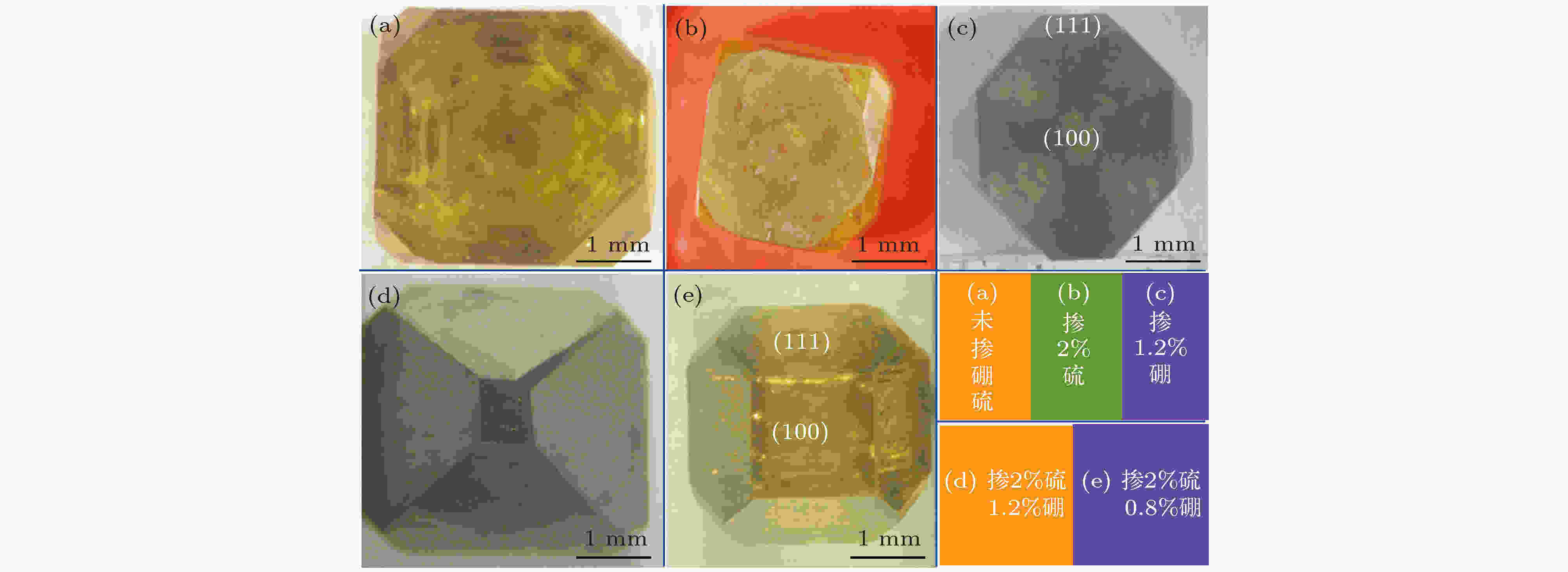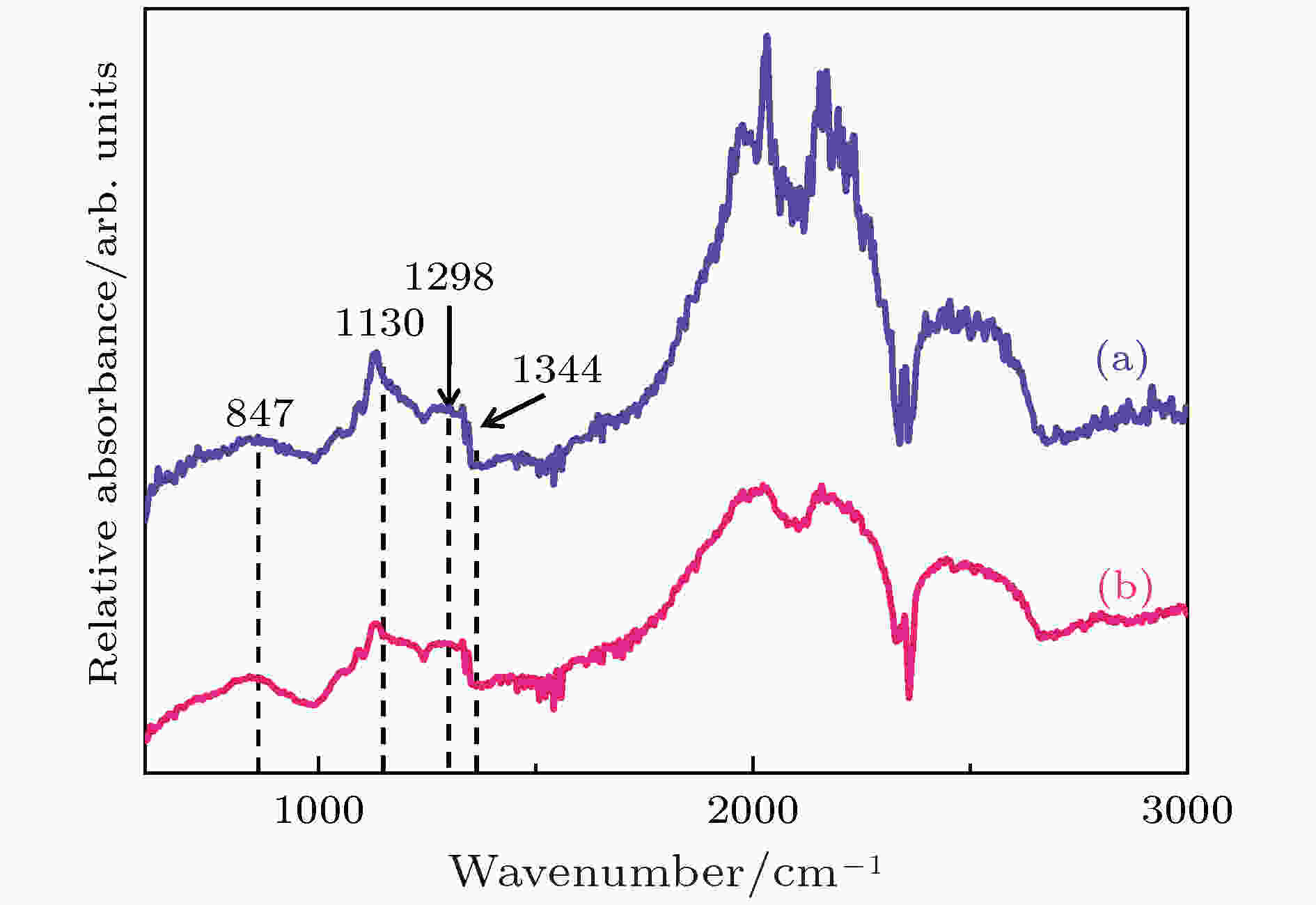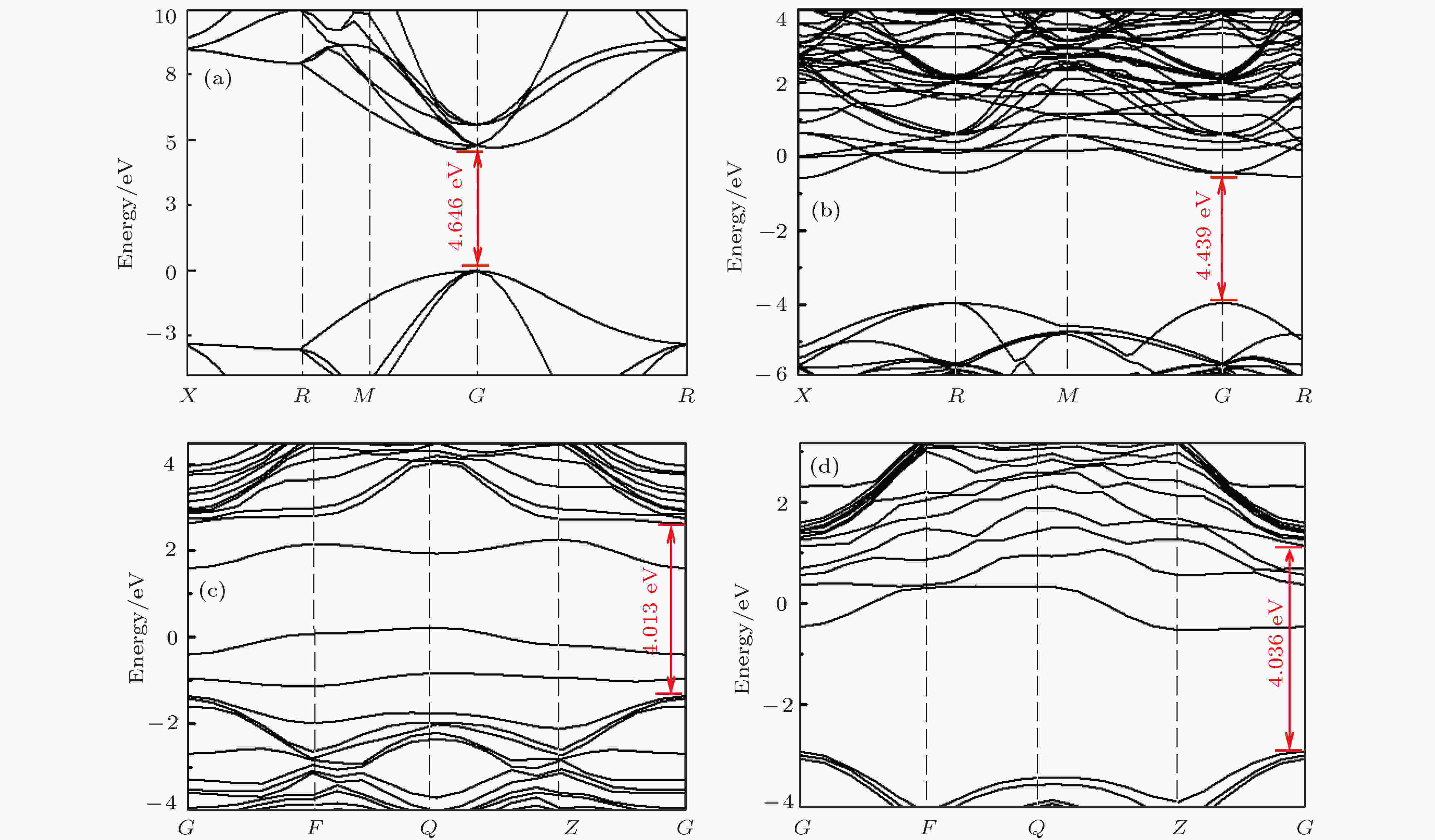全文HTML
--> --> -->在金刚石合成制备体系中掺入硼元素, 可以实现p型金刚石半导体的制备, 甚至在特定条件下可呈现出超导现象[6]. 然而, 具有优异电输运性能的n型金刚石半导体制备仍是尚未攻克的技术难题, 根本原因在于尚未找到一种理想的供体元素. 对于第一族的锂元素和钠元素而言, 它们在金刚石中的溶解度以及扩散度都较低, 在热力学平衡下它们甚至不能进入到金刚石晶体结构中. 在采用离子注入法制备n型金刚石半导体的过程中[7], 由于离子具有非常高的能量, 其会对金刚石的晶格结构造成破坏, 使晶体局部产生由sp3杂化金刚石结构到sp2杂化石墨结构的相变. 尽管离子注入法可以使金刚石电导率提高, 但其电导率提高的机制在于相变所产生的石墨畴所致, 而并非金刚石中的电活性施主杂质引起的. 氮(N)虽然作为一种潜在的供体元素, 然而实验和理论计算结果均表明氮在金刚石中处于深能级状态, 不利于提高其电输运性能, 因此, 目前在n型金刚石半导体的制备研究中, 很少考虑将氮作为施主杂质使用. Jackson等[8]和Cao等[9]将磷单质作为n型金刚石的供体杂质进行了研究, 然而测试结果表明磷在金刚石结构中产生了较为严重的团聚现象, 使得所制备金刚石薄膜的电输运性能并不理想. 另外, 由于硫单质的原子半径较大, 不利于掺杂的进行, 因此硫也并非理想供体杂质. 由此可见, 使用单一元素掺杂制备合成理想的n型金刚石半导体材料存在诸多困难.
协同掺杂会导致金刚石Raman峰产生一定的位移, 并对金刚石的红外吸收、电学性能、晶体形貌、晶体结构产生一定的影响[10-12]. 此外, 日本****Katayama等[13]通过理论计算研究证明, 协同掺杂可以对金刚石能带进行有效调节, 进而有望解决n型及p型宽带隙半导体的制备问题. 同时, 实验研究结果表明, 硼氢协同掺杂所制备的金刚石表现为p型半导体, 而且在合成体系中硼添加量一定的前提下, 掺杂元素氢的协同作用会导致所制备的金刚石大单晶的电导率提高两个数量级[14]. 这些理论和实验成果为我们进一步研究硼硫协同掺杂金刚石大单晶的制备奠定了良好的工作基础.
基于上述讨论, 本文主要研究了硼硫协同掺杂金刚石大单晶的高温高压合成, 并借助霍尔效应对所制备的典型金刚石进行了相应测试. 此外, 采用第一性原理, 从微观机制上对协同掺杂金刚石大单晶的相应电子结构进行了研究, 并进一步研究了其电学性能的变化. 理论计算结果与实验测试结果吻合较好, 进一步证明了协同掺杂在调整金刚石电学性能方面的有效作用.
 图 1 金刚石合成腔体示意图(1, 钢帽; 2, 石墨片; 3, 氯化钠管; 4, 陶瓷堵头; 5, 石墨加热管; 6, 触媒; 7, 碳源; 8, 绝缘管; 9, 晶种; 10, 叶蜡石)
图 1 金刚石合成腔体示意图(1, 钢帽; 2, 石墨片; 3, 氯化钠管; 4, 陶瓷堵头; 5, 石墨加热管; 6, 触媒; 7, 碳源; 8, 绝缘管; 9, 晶种; 10, 叶蜡石)Figure1. Schematic of the cell for diamond synthesis (1, conductive ring; 2, graphite sheet; 3, NaCl tube; 4, ceramic cylinder and cover; 5, graphite heater; 6, catalyst; 7, carbon source; 8, insulation tube; 9, seed crystal; 10, pyrophyllite).
理论计算部分为基于密度泛函理论的平面波超软赝势方法, 文中所涉及的自旋体系均采用VASP软件进行计算. 计算过程中, 电子间的交换关联能采用广义梯度近似下的Perdew-Bueke-Ernzerhof泛函方法处理. 在倒格矢空间, 计算采用的平面波截断能为400 eV, Monkhorst-pack特殊K点为4 × 4 × 4. 金刚石晶格中所掺杂硼、硫均以替代碳原子位置的形式, 并对所对应的能带结构进行了对比.
| Sample | B/% | S/% | 温度/℃ | 颜色 |
| (a) | — | — | 1280 | 黄色 |
| (b) | — | 2.0 | 1280 | 黄色 |
| (c) | 1.2 | — | 1280 | 黄黑色 |
| (d) | 1.2 | 2.0 | 1300 | 黑色 |
| (e) | 0.8 | 2.0 | 1290 | 黄色 |
表1金刚石合成参数
Table1.Parameters of the synthetic experiments of diamond performed at 6.5 GPa in the FeNiMnCo-C system.
 图 2 FeNiMnCo-C体系中所合成的金刚石光学照片
图 2 FeNiMnCo-C体系中所合成的金刚石光学照片Figure2. Optical images of diamond synthesized in FeNiMnCo-C system.
傅里叶红外光谱(FTIR)测试是一种无伤、有效的检测金刚石中杂质的手段 [16]. 众所周知, 对于合成体系中未掺入添加剂时, 高温高压条件下所合成的金刚石中的主要杂质缺陷为替代位的氮杂质, 其所对应的红外特征吸收峰分别位于1130和1344 cm–1处, 且金刚石中的氮杂质浓度约为300 ppm [17]. 此外, 金刚石中的硫杂质红外特征吸收峰位于847 cm–1处[5]. 为了分析硼硫协同掺杂金刚石中的杂质, 分别对图2中的硼硫协同掺杂样品进行了红外光谱测试, 测试结果如图3所示. 从谱线(a)和(b)可以看到, 两条谱线中均含有氮所对应的吸收峰, 且谱线(a)中1130 cm–1处的吸收强度要略强于谱线(b), 而两个样品中硼所对应的吸收峰均较弱, 位于1298 cm–1处[14]. 另外, 两条谱线中均有硫所对应的847 cm–1特征吸收峰存在, 这意味着硼、硫均进入到金刚石结构中, 且谱线(b)所对应硫的红外吸收强度要略强于谱线(a). 然而, 通过红外光谱测试并未发现硼-硫基团所对应的特征吸收峰, 这说明硼与硫极有可能均以替代形式位于金刚石晶格之中. 根据国际上公认的金刚石中氮浓度计算公式[18],
 图 3 硼硫协同掺杂金刚石的红外光谱 (a)添加1.2%硼和添加2.0%硫; (b)添加0.8%硼和添加2.0%硫
图 3 硼硫协同掺杂金刚石的红外光谱 (a)添加1.2%硼和添加2.0%硫; (b)添加0.8%硼和添加2.0%硫Figure3. FTIR spectra of diamond co-doped with B and S: (a) With 1.2% B and 2.0% S additives; (b) with 0.8% B and 2.0% S additives.


为了表征所制备的五个典型金刚石晶体的电学特性, 在常温常压条件下对样品进行了霍尔效应测试, 测试结果如表2所列. 由于晶体(a)未进行硼或硫掺杂, 故呈现为绝缘体. 对于合成体系中添加2.0 wt.%硫所合成的金刚石(b), 其电阻率为4.417 × 106 Ω·cm, 霍尔系数为负值, 这说明硫掺杂金刚石具有较弱的n型半导体特性, 其原因为硫存在于金刚石晶格之中并充当了供体杂质. 对于金刚石而言, 硼元素是典型的受主元素, 金刚石晶格之中硼的存在会致使金刚石表现为p型半导体行为. 当合成体系中同时添加2.0 wt.%硫和1.2 wt.%的硼时所制备的金刚石, 所对应晶体(d)仍然具有p型半导体特性. 当提高合成体系中硫对硼的相对比例时, 所合成的金刚石所对应的霍尔系数又重新变为负值, 意味着金刚石随着合成体系中硫对硼的相对比例的提高导致金刚石从p型向n型转变. 硼、硫最外层的价电子数分别为3和6, 且硼原子半径(0.082 nm)与碳原子半径(0.077 nm)接近, 而硫原子半径为0.110 nm, 相对硫元素而言, 硼更容易占据金刚石晶格位置. 金刚石(d)和(e)由p型向n型的转变可以从硼硫的电子结构进行了推测: 当合成体系中硫对硼的掺杂比例相对较低时, 由于硼原子进入到金刚石中数量比硫进入到金刚石中的数量多, 致使硼与周围的碳原子形成共价键时所产生的空穴的数量要多于硫与周围碳原子形成共价键时所提供的多余电子数量, 因此所制备的晶体(d)具有p型半导体性质; 当提高合成体系中硫对硼的掺杂比例时, 进入到金刚石晶格中硫元素的数量提升, 此时硫与周围碳原子形成共价键时所提供的多余电子数量要大于硼与周围碳原子形成共价键时所产生的空穴数量, 因此晶体(e)具有n型半导体特征; 甚至可以大胆地推测, 当硫进入到金刚石中所提供的多余电子与硼进入到金刚石中所产生的空穴数量相当时, 所制备的金刚石将会呈现为绝缘体. 霍尔效应测试结果非常有趣的是, 对比晶体(c)和(d), 观察到合成体系中硼掺杂量不变的前提下, 由于硫的协同掺杂作用, 导致了金刚石(d)的电导率从3.665 × 103 Ω·cm降到8.510 Ω·cm, 下降了3个数量级. 金刚石中富硼区域为黑色, 对于晶体(d), 其(111)面非常发达, 此时硼更加容易进入到金刚石中[20], 因此呈p型. 此时, 硼对金刚石的导电起关键作用, 而且硼在金刚石中处于浅能级, 故导电性能较好. 而金刚石(e)呈n型, 由于硫的原子半径较大, 致使其在金刚石中的溶解度不高. 此外, 硫在金刚石中所提供的电子还要弥补金刚石中由于硼存在所产生的空穴, 以至于该晶体中剩余的电子不够富裕, 导致该样品的电导率急剧下降.
| Sample | 电阻率/Ω·cm | 载流子浓度/cm–3 | 迁移率/cm–2·V–1·s–1 | Hall系数 |
| (a) | > 108 | — | — | — |
| (b) | 4.417 × 106 | 5.383 × 109 | 262.853 | –1.151 × 109 |
| (c) | 3.665 × 103 | 1.364 × 1016 | 12.5 | 4.586 × 104 |
| (d) | 8.510 | 6.652 × 1014 | 760.870 | 6.475 × 103 |
| (e) | 1.262 × 106 | 8.738 × 1010 | 56.680 | –7.153 × 107 |
表2金刚石样品的电学性能参数((a)未添加硼与硫, (b)添加2.0%硫, (c)添加1.2%硼, (d)添加1.2%硼和2.0%硫, (e)添加0.8%硼和2.0 %硫)
Table2.Electrical performance parameters of the diamond samples measured at room temperature ((a) without B or S additives, (b) with 2.0 wt.% S additive, (c) with 1.2% B additive, (d) with 1.2% B and 2.0% S additives, (e) with 0.8% B and 2.0% S additives).
为进一步深入解释不同掺杂对金刚石电学性质的影响, 使用第一性原理对相关掺杂进行了理论计算. 由本课题组以前的研究可知[21,22], 实验过程中由于间隙掺杂的形成能较替位掺杂更高, 本文计算过程中的硼、硫均采用替位掺杂方式. 图4(a)为无任何添加剂的金刚石能带结构. 图4(b)给出了硫掺杂比例为2%的金刚石所对应的能带图, 由该图可以看出: 费米面靠近导带底, 证明硫元素单掺杂使金刚石呈现出n型半导体性能; 然而, 由于掺杂所得金刚石禁带宽度较大(为4.439 eV), 电子从价带顶跃迁至导带底实现导电需要外界提供较大的能量, 从而表现出较高的电阻率, 与表2所述实验结果吻合较好. 当硼元素进一步协同掺杂后, 其能带图如图4(c)所示, 即: 1) B的进一步掺杂使费米面出现在价带顶部, 使金刚石呈现p型半导体特性; 2)由于硼硫共掺杂而导致禁带宽度变窄至4.013 eV左右, 较S单掺杂减小约0.4 eV, 使电子更易实现从价带顶向导带底的跃迁, 与表2中霍尔测试结果相吻合; 3)由于B掺杂比例较S少, 从而使晶体中出现富余的电子, 而在禁带中出现大量杂质能级, 进一步减小了金刚石的电阻率; 4)协同掺杂使晶体中富余的电子为未成键电子, 因此其有效质量较大, 不利于金刚石的载流子迁移率的提升; 同时杂质能级分散在费米面两侧, 易实现载流子的复合, 进一步限制了载流子浓度的提升. 当进一步减小B的含量, 其能带结构如图4(d)所示, 其能带表现出与S单掺杂类似的半导体性能, 为典型的n型半导体; 与此同时, 由于S掺杂占主导作用, 因此其杂质能级需要出现在导带底, 材料禁带宽度较S单掺杂时变化不大, 因此获得了和S单掺杂相类似的电阻率及载流子浓度(如表2所列), 与实验吻合较好. 然而, 由于B的引入, 使S杂质能级主要出现在导带底, 同时使导带底部能级出现展开的同时价带顶部能级基本不变, 利于电子的跃迁, 从而电阻率约为S单掺杂的1/3; 由于杂质能级电子未成键, 由能带曲线曲率可以看出, 其有效质量较大, 不利于迁移率的提升, 其迁移率较S单掺杂小, 与实验结果中的数值相符.
 图 4 金刚石能带结构 (a)未添加硼与硫; (b)添加2.0%硫; (c)添加1.2%硼和2.0%硫; (d)添加0.8%硼和2.0%硫
图 4 金刚石能带结构 (a)未添加硼与硫; (b)添加2.0%硫; (c)添加1.2%硼和2.0%硫; (d)添加0.8%硼和2.0%硫Figure4. Band structures of the synthesized diamond: (a) Without B or S additive; (b) with 2.0% S additive; (c) with 1.2% B and 2.0% S additives; (d) with 0.8% B and 2.0% S additives.
